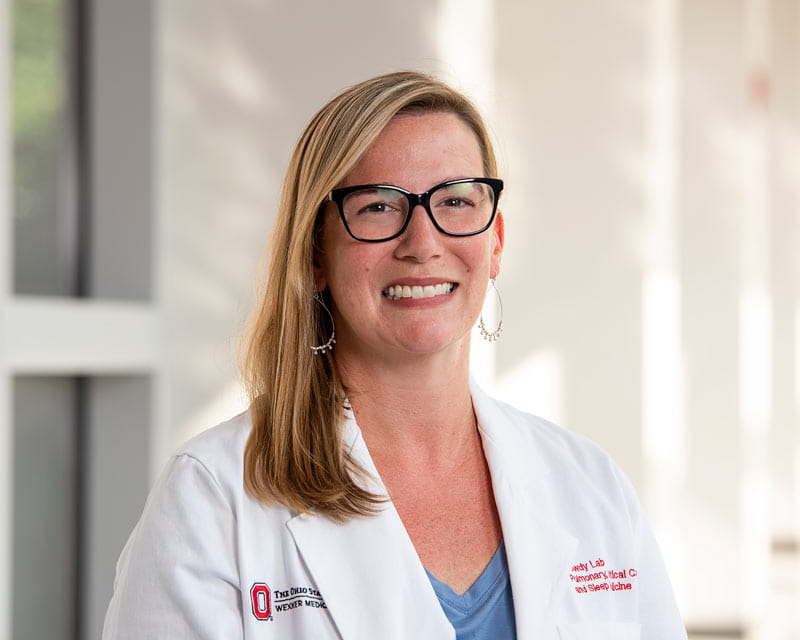
Ohio State Researchers Launch NIH-Funded Study on Ozone-Induced Pulmonary Inflammation
 An innovative program designed to improve detection of early lung cancer is expected to be operational at The Ohio State University Wexner Medical Center by February 2022.
An innovative program designed to improve detection of early lung cancer is expected to be operational at The Ohio State University Wexner Medical Center by February 2022.
By bolstering the follow-up done on patients with incidental lung nodules, the program is expected to increase the rate of early lung cancer detection.
The program is spearheaded by Jasleen Pannu, MBBS, a pulmonary and critical care medicine physician. Pannu is also an assistant professor and director of Interventional Pulmonary Translational Research at the Ohio State Wexner Medical Center.
Nationwide, approximately 1.2 million lung nodules are detected incidentally on chest computed tomography (CT) scans each year. Yet only about 30% of these are followed up appropriately according to Fleischner Society Guidelines.
“That’s a huge opportunity lost when it comes to finding early-stage lung cancer,” Pannu says.
“In a large institution like Ohio State, approximately 10,000 lung nodules are detected on CT scans in a year,” Pannu says. About 1,000 of these are new detections, and 5% to 10% of them could end up being malignant. Potentially, that’s 100 cases of early cancer that could be found with the right follow-up. “That’s significant,” Pannu says.
The program came to fruition thanks to a three-year, $500,000 Patient Care Innovation Award presented to Pannu by The Ohio State University Physicians, Inc., the multispecialty physician faculty practice plan for The Ohio State University College of Medicine.
Since 2016, OSU Physicians, Inc., has awarded $3 million annually to Ohio State College of Medicine faculty-led projects that focus on improving access to care and care delivery for underserved populations while lowering overall costs. Patients who smoke and lack access to quality health care because of where they live or financial challenges are among those expected to benefit most from the Lung Nodule Program.
Reasons for the lack of follow-up on incidental lung nodules are many and varied. Sometimes patients aren’t informed of incidental findings, or even if they are, they may not know what to do about them.
Other times, patients don’t live in an area where the lung nodule can be readily evaluated, or they’re unable to get a timely appointment with a specialist.
The Lung Nodule Program at the Ohio State Wexner Medical Center will address all these barriers to care and could benefit many people with these findings.
The program, which will work closely with the Lung Cancer Screening Clinic of The Ohio State University Comprehensive Cancer Center – Arthur G. James Cancer Hospital and Richard J. Solove Research Institute, will consist of automated lung nodule detection and follow-up tools, in-person and telemedicine-based patient communication, and patient navigation led by a nurse navigator, nurse practitioner and physician.
A natural language processing software program will automatically review radiology reports after a CT scan is performed within the Ohio State Wexner Medical Center system. Scans that reveal a lung nodule will be flagged, and patients will be stratified according to urgency of follow-up. The program’s nurse navigator will then review these patients’ scans daily to identify individuals at greatest risk based on national guidelines.
Patient cases will be evaluated in weekly meetings of the program team (the nurse navigator, nurse practitioner and physician). The team will then inform the patient’s primary care physician (PCP) and/or patients of their findings. PCPs and patients may opt to manage their findings locally, or if they prefer, patients can be seen by the program team in the new weekly, half-day Lung Nodule Clinic in The James Thoracic Oncology Center. Self-referrals from patients are accepted, as well. Video and teleconferencing options will be available for those in remote locations and anyone unable to attend in-person appointments so that follow-up will not be delayed.
“If the patient needs a biopsy, we’ll facilitate that through a fast-track referral,” Pannu says. “If the patient needs surgical removal of the nodule, that would be facilitated as well. And if the patient needs a follow-up scan, that would be scheduled. And patients will be reminded of their upcoming follow-up appointments.”
Navigators will guide patients through next steps. Patient navigation is known to lead to quicker biopsies and has resulted in improved early-stage detection and five-year survival for breast and colon cancer patients. That suggests that similar results could be expected with lung cancer programs as well.
The Lung Nodule Program is staffed with pulmonology experts in close collaboration with specialists in Radiology, Thoracic Surgery, Medical Oncology and Radiation Oncology.
“All of these departments that work closely with lung cancer detection and treatment have come together cohesively,” Pannu says. “This program has multiple steps that have intricately taken into account the needs of patients at every level.”
The program outlines the workflow and communication process with ordering providers, PCPs and patients to ensure each patient is appropriately evaluated, and important information does not slip through the cracks. Thanks to the patient-management component built into the software, people will even receive reminders if they miss follow-up appointments.
Pannu intends to compare post-intervention data to baseline statistics from 2018 to assess changes in lung nodule and lung cancer detections after appropriate follow-up is ensured, rate of sentinel events, incidence of missed detections and lung cancer stage-shift. She expects her research will show improvement in all areas and more cancer will be detected at an earlier stage.
New director of Interventional Pulmonology (IP) Nicholas Pastis, MD, who was recruited to the Ohio State Wexner Medical Center from the Medical University of South Carolina in August 2021, says endeavors like the Lung Nodule Program, and particularly the research that will track its impact, will advance Interventional Pulmonology at the medical center and further solidify its national reputation in pulmonology care.
“It’s already an extremely strong clinical program with very talented IP physicians,” Pastis says. “I think more of a presence in major journals related to IP and lung cancer are what will help get Ohio State’s IP program to the very highest level.”
Pastis was drawn to the Ohio State Wexner Medical Center by the opportunities, support and investment in advanced equipment, like the cone-beam CT in the bronchoscopy suite that will aid in the early diagnosis and treatment of lung cancer.
“There was a tremendous investment by the James Cancer Center and Ohio State to provide us with state-of-the-art equipment that few centers have,” Pastis says. Validating new technologies being used in the bronchoscopy suite will be one goal of future research.
A highly regarded medical educator, Pastis will also serve as director of the Interventional Pulmonology fellowship program. Along with building the research portfolio of the IP team, he hopes to strengthen learning opportunities for both IP and general pulmonologists.
“I’d like to capitalize on the opportunity for education, not only for Interventional Pulmonology Fellows but also people in the central Ohio area through having some local courses on bronchoscopy and pleural disease,” Pastis says. “It’s an opportunity to show the services we have to offer and to provide a learning opportunity.”
As a practicing interventional pulmonologist, he and his team will always focus on patients first. Using sophisticated equipment and advancing medicine is essential, but so is taking the time to have a conversation with patients and getting to know them.
“We look at ourselves as physicians first,” he says, “and proceduralists second.”
Learn more about innovations in care and research from the Division of Pulmonary, Critical Care and Sleep Medicine.